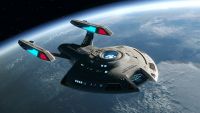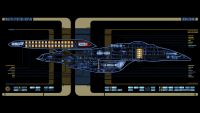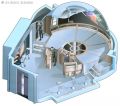Difference between revisions of "Nova Class"
m |
m |
||
| (6 intermediate revisions by the same user not shown) | |||
| Line 1: | Line 1: | ||
| − | + | __NOEDITSECTION____NOTOC__ | |
{{Sidebar\starship | {{Sidebar\starship | ||
| − | | ship name = | + | | ship name = Nova Class Survey Vessel |
| allegiance = United Federation of Planets | | allegiance = United Federation of Planets | ||
| image = RhodeIsland.jpg | | image = RhodeIsland.jpg | ||
| image3 = | | image3 = | ||
| − | | image4 = RIMSD. | + | | image4 = RIMSD.jpg |
| − | | class = | + | | class = Nova Class |
| specifications = | | specifications = | ||
}} | }} | ||
| − | + | ===Overview=== | |
| − | + | The Nova-class was designed as a science and scout vessel, intended for short-term planetary research and analysis as a replacement for the aged Oberth-class. Designed to be small and easy to operate and maintain, the initial design was a rejected proposal for the [[Defiant Class]] Escort, the tactical systems stripped out and replaced by advanced sensor suites and tried-and-tested internal systems. | |
| − | + | ===Capabilities=== | |
| − | + | Despite not being designed as a tactical vessel, the Nova-class is remarkably well-armed for a ship of its size with eleven phaser arrays and a pair of forward torpedo tubes. The single Impulse Engine mounted at the aft end of the primary hull is powerful for its size, giving the Nova-class excellent acceleration and agility for getting into and out of trouble, but at the expense of redundancy. The class' true calling, however, is as a scout or survey vessel; designed with the most advanced sensors of the time in mind, and equipped with a pair of powerful computer cores, the diminutive Nova-class can survey a planet or solar system at a greater speed than its larger cousins. Four landing legs allow the Nova-class to land on the planet it is surveying and act as a research outpost, if required. | |
| − | + | Initially the Nova-class was designed with an LF-47 Advanced Linear Warp Drive with undersized warp coils, limiting its cruising velocity to a sedate Warp 6 and its maximum speed to Warp 8. A larger unit was not available for installation until, after the Synth Attack on Mars, a comprehensive refit program for all Starfleet vessels was ordered to make up for the loss of shipbuilding capability associated with Utopia Planitia's destruction. The new core and larger warp coils were installed across the Nova fleet, and increased the class' emergency velocity to 9.92 for a period of 12 hours, though this would drain the ship's deuterium supply and put immense strain on its structural integrity field. | |
| − | + | Designed for short missions of only a few months, the initial run of Nova-class vessels lacked dedicated crew recreation facilities. As Nova-class starships were pressed into longer-duration missions, however, internal configurations were revisited, usually deleting Crew Quarters to acommodate a dedicated Holodeck or Arboterum; the increasingly-cramped living environment was deemed justifiable for both the morale of the crew, but also to engage in studies around the emotional and social health of crews on long voyages. Despite the longer-duration missions, most Nova-class ships operate without a Counsellor, though the new-generation EMH based on the EXEO program is more than capable of acting in this capacity. | |
| − | + | The immense amount of lab space available to the Nova-class has made it a more-than-capable medical or crisis-response vessel, able to respond to an emergency quicker than a dedicated hospital ship and act as a triage or crisis response center. It has also been rumoured that the class' diminutive size and nonthreatening nature have attracted the eye of Starfleet Intelligence as an Electronic Intelligence (ELINT) vessel, though these claims remain unsubstantiated. | |
| − | + | ===Mission Profiles=== | |
| − | + | Pathfinder and Reconnaissance Operations, Scientific and Survey Operations, Crisis and Emergency Response. | |
| − | |||
| − | |||
===Vessels of Note=== | ===Vessels of Note=== | ||
| Line 39: | Line 37: | ||
|} | |} | ||
| − | ==Image Gallery== | + | ===Image Gallery=== |
| − | ===Command Areas=== | + | ====Command Areas==== |
<gallery> | <gallery> | ||
| Line 49: | Line 47: | ||
</gallery> | </gallery> | ||
| − | ===Operational Areas=== | + | ====Operational Areas==== |
<gallery> | <gallery> | ||
| − | Image:RIEngineering.jpg|Engineering | + | Image:RIEngineering.jpg|Engineering (Main Level) |
| − | Image:RIScience.jpg|Science | + | Image:RIEngineeringTop.jpg|Engineering (Upper Level) |
| + | Image:RIScience.jpg|Science Lab (Typical) | ||
Image:RISickbay.jpg|Sickbay | Image:RISickbay.jpg|Sickbay | ||
| + | Image:YeagerTypeAstro.jpg|Astrometrics Lab | ||
Image:RIComp.jpg|Computer Core | Image:RIComp.jpg|Computer Core | ||
</gallery> | </gallery> | ||
| − | ===Crew Areas=== | + | ====Crew Areas==== |
<gallery> | <gallery> | ||
Image:RICO.jpg|Captain Braggins' Quarters | Image:RICO.jpg|Captain Braggins' Quarters | ||
| − | Image: | + | Image:RISrOff.jpg|Officers' Quarters |
Image:RIEnl.jpg|Enlisted Quarters | Image:RIEnl.jpg|Enlisted Quarters | ||
| + | Image:RILounge.jpg|Officer's Lounge | ||
Image:RIMess.jpg|Mess Hall | Image:RIMess.jpg|Mess Hall | ||
</gallery> | </gallery> | ||
| − | ===Other Areas=== | + | ====Other Areas==== |
<gallery> | <gallery> | ||
| − | Image:RICarg1.jpg|Cargo Bay | + | Image:RICarg1.jpg|Cargo Bay |
| − | |||
Image:RIWave.jpg|Waverider Dock | Image:RIWave.jpg|Waverider Dock | ||
Image:RIShuttlebay.jpg|Shuttlebay | Image:RIShuttlebay.jpg|Shuttlebay | ||
Image:RITrans.jpg|Transporter Room | Image:RITrans.jpg|Transporter Room | ||
</gallery> | </gallery> | ||
| + | |||
[[Category: Starship]] | [[Category: Starship]] | ||
[[Category: Engineering]] | [[Category: Engineering]] | ||
Latest revision as of 20:36, 4 July 2023
| STARSHIP | |
|---|---|
 | |
| Class | Nova Class |
| Allegiance | United Federation of Planets |
 | |
| Specifications | |
| Type: | Scout/Surveyor |
| Length: | 220 Meters |
| Beam: | 62 Meters |
| Height: | 34 Meters |
| Mass: | 80,000 Metric Tons |
| Decks: | 8 Deck Plans |
| Crew Compliment: | Standard: 15 Officers, 65 Enlisted Crew Breakdown Emergency: 200 |
| Warp Speed: | Cruise Speed: 6 Sustainable Speed: 8 Emergency Speed: 9 (12 hour automatic shutdown) |
| Impulse Engines: | 1 Main Impulse Engine (Type 5) Speed: .93 C |
| Defensive Systems: | Type 4 Main Shield Generator (MSG-4) |
| Armament: | Phasers: 4x 100-degree Type-I Arrays; two dorsal, two ventral (Saucer); 2x 60-degree Type-I Arrays (Aft Saucer); 3x 90 degree Type-I Array; two aft, one ventral (Secondary Hull) |
| Other Capabilities: | Planet Landing Capabilities - Blue Alert |
| Computer System: | Daystrom Industries HSCS-3 |
| Tractor/Repulsor: | 2 Main Tractor/Repulsor Beams, 2 Docking Tractors, 2 Shuttle Tractors |
| Shuttlecraft: | 1 Bay (A), 2 Shuttles (2 Type 12); Waverider Support Craft (Docked Under Saucer) |
| Sensors: | SS Sierra 1a8 Deep Space Scientific Sensors Daystrom Industries HSCS-2SC-C Starship Sensors |
Overview
The Nova-class was designed as a science and scout vessel, intended for short-term planetary research and analysis as a replacement for the aged Oberth-class. Designed to be small and easy to operate and maintain, the initial design was a rejected proposal for the Defiant Class Escort, the tactical systems stripped out and replaced by advanced sensor suites and tried-and-tested internal systems.
Capabilities
Despite not being designed as a tactical vessel, the Nova-class is remarkably well-armed for a ship of its size with eleven phaser arrays and a pair of forward torpedo tubes. The single Impulse Engine mounted at the aft end of the primary hull is powerful for its size, giving the Nova-class excellent acceleration and agility for getting into and out of trouble, but at the expense of redundancy. The class' true calling, however, is as a scout or survey vessel; designed with the most advanced sensors of the time in mind, and equipped with a pair of powerful computer cores, the diminutive Nova-class can survey a planet or solar system at a greater speed than its larger cousins. Four landing legs allow the Nova-class to land on the planet it is surveying and act as a research outpost, if required.
Initially the Nova-class was designed with an LF-47 Advanced Linear Warp Drive with undersized warp coils, limiting its cruising velocity to a sedate Warp 6 and its maximum speed to Warp 8. A larger unit was not available for installation until, after the Synth Attack on Mars, a comprehensive refit program for all Starfleet vessels was ordered to make up for the loss of shipbuilding capability associated with Utopia Planitia's destruction. The new core and larger warp coils were installed across the Nova fleet, and increased the class' emergency velocity to 9.92 for a period of 12 hours, though this would drain the ship's deuterium supply and put immense strain on its structural integrity field.
Designed for short missions of only a few months, the initial run of Nova-class vessels lacked dedicated crew recreation facilities. As Nova-class starships were pressed into longer-duration missions, however, internal configurations were revisited, usually deleting Crew Quarters to acommodate a dedicated Holodeck or Arboterum; the increasingly-cramped living environment was deemed justifiable for both the morale of the crew, but also to engage in studies around the emotional and social health of crews on long voyages. Despite the longer-duration missions, most Nova-class ships operate without a Counsellor, though the new-generation EMH based on the EXEO program is more than capable of acting in this capacity.
The immense amount of lab space available to the Nova-class has made it a more-than-capable medical or crisis-response vessel, able to respond to an emergency quicker than a dedicated hospital ship and act as a triage or crisis response center. It has also been rumoured that the class' diminutive size and nonthreatening nature have attracted the eye of Starfleet Intelligence as an Electronic Intelligence (ELINT) vessel, though these claims remain unsubstantiated.
Mission Profiles
Pathfinder and Reconnaissance Operations, Scientific and Survey Operations, Crisis and Emergency Response.
Vessels of Note
| Name | Registry | Status |
|---|---|---|
| USS Philadelphia | FSV-66053 | Active |

















